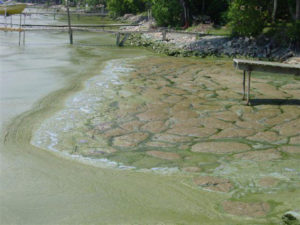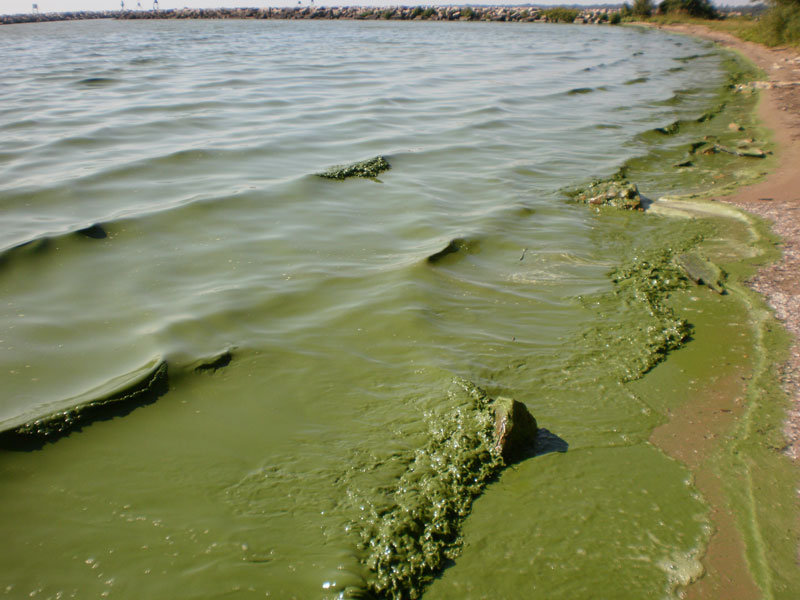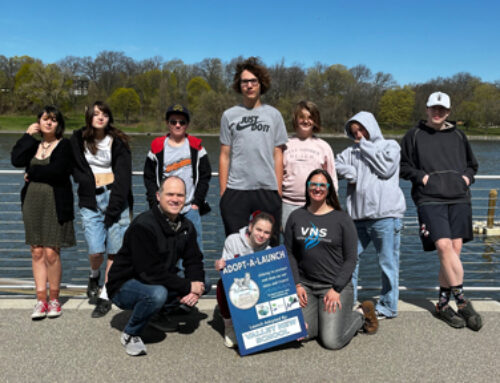The combination of high temperatures and recent storms resulted in the Winnebago Pool Lakes looking like what many described as ‘pea soup’. The green, paint-like film is a blue-green algae bloom, also known as cyanobacteria.

Blue-green algae. Credit: Rob McLennan, WDNR
Contrary to the name, blue-green algae are a type of bacteria and not actually algae. Blue-green algae can release toxins that are harmful to both humans and pets. While not all blue-green algae produce harmful toxins, those that do can cause rashes, diarrhea, respiratory problems, and, in rare cases, liver failure.
People can be exposed to blue-green algae through accidental ingestion while swimming, inhaling water spray (aerosols) during water recreation (such as boating), or by simply being in the water where a bloom is occurring. You can reduce your risk of exposure by staying out of water that looks unappealing like pea soup or where there is a layer of scum, foam, or mats of algae on the water surface. The thicker the bloom the higher the risk is to you and your pets. When in doubt, it’s best to keep out!
If you come into contact with water that has an active algal bloom, rinse off immediately. Get medical treatment right away if you think you may have been poisoned by a harmful algal bloom. Call your veterinarian if your pets show signs of blue-green algae poisoning, such as: lethargy, seizures, vomiting, diarrhea, convulsions, difficulty breathing, or general weakness.
Conditions can change rapidly with some blooms lasting hours and others lasting days. Winds can push blooms across the lakes, causing the blue-green algae to build up in certain areas. The worst blooms occur when temperatures are high and phosphorus is plentiful.
“Phosphorus acts like a food for blue-green algae fueling large blooms”, says Korin Doering, Winnebago Waterways Program Coordinator. “If we can reduce the amount of phosphorus going into our lakes we can reduce the number of large algae blooms that occur each year, making our lakes safer and more enjoyable.”
 Phosphorus is found naturally in grass clippings and leave in urban areas and in manure that is applied to our agricultural landscapes. When it rains, water picks up phosphorus and carries it into the lakes contributing to the increase in algae.
Phosphorus is found naturally in grass clippings and leave in urban areas and in manure that is applied to our agricultural landscapes. When it rains, water picks up phosphorus and carries it into the lakes contributing to the increase in algae.
Reducing phosphorus runoff from urban and agricultural sources is a top priority of the Winnebago Waterways Program at Fox-Wolf Watershed Alliance. They are currently working with the counties and other project partners to develop a lake management plan that will recommend ways people in the region can work together to reduce the amount of phosphorus entering the lakes.
There are several things you can do to help reduce algae blooms. A few examples include: sweeping grass clippings off of sidewalks and roadways to keep them from going into storm drains, picking up pet waste, and preventing water from running off of your property by using a rain barrel. You can also help by donating to Fox-Wolf Watershed Alliance at www.FWWA.org.
For more information about the Winnebago Waterways Program or Lake Management Planning efforts, please visit www.winnebagowaterways.org or call Korin Doering at (920)851-0948. Fox-Wolf Watershed Alliance is an independent nonprofit organization that works to protect, restore, and sustain water resources in the Fox-Wolf River Basin.
![]()






